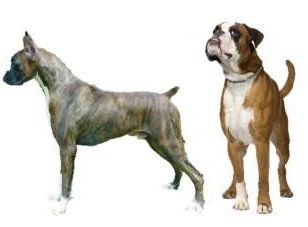Docking Boxer Tails

There is quite a difference in appearance between a Boxer with a docked tail and one with a natural tail.
Overview
The debate regarding docking a Boxer's tail is side by side with ear cropping. Look to our
Ears - To Crop or Not to see which countries allow this and which deem it illegal.
Usually, if an owner decides to crop the ears, they will also have the Boxer's tail docked. Docking is the process of having a certain percentage of a Boxer puppy or dog's natural tail removed. This is done to produce a short tail that stands erect.

Mr. Riley | Photo courtesy of Tom and Tori McDonald
What Exactly is Docking?

Billy the Boxer | Photo courtesy of James and Joanna Murphy
It is believed that the puppy feels this amputation, since most puppies let out a very loud yelp, however they seem to recover quite quickly.
Why Are Boxer Dog Tails Docked?
Long ago, it was thought to prevent rabies and increase the dog's running speed; however this has been proven false. With this said, docking has also been done for centuries to prevent damage to the tail. There are no specific records that show why this train of thought was applied to some breeds and not to others.
At this point, with docking being done for so many generations, those in favor of this argue that if docking were to suddenly stop, the Boxer breed would not carry 'good tails' (tails would too heavy to sit correctly, the dog's balance would be off, etc.)...
The deliberation between those who favor it and those who are against it goes on to say that within a short amount of time the only breeding pool available would be dogs with 'bad' tails that could not produce viable offspring. Of course, all of this is debatable and the Boxer breed is as strong as ever in countries where this is illegal.
Putting health and breeding issues aside, some simply believe that a Boxer should have cropped ears and a docked tail to have the "Boxer look".
Consensus among those who do choose docking, dictates that the dog looks stronger, more powerful and more intimidating with the cropped and docked appearance.
Those who have a dog with a natural tail or those who have a litter of newborns and choose to forgo this procedure should feel just fine about that decision...many owners have dogs with the tails that nature gave them.
In regard to dog show requirements, the debate is still on. Some clubs do not give an advantage to a docked dog and others state that docking is expected for a Boxer to conform to requirements.
When is Docking Done?
Many Boxer breeders will have a puppy docked very early, within a few days of being born. Since a dog is not sold or given to a new owner until the age of at least 8 weeks, many owners do not see the docking process or the healing process. Although this may make some cringe, if a
Boxer puppy under 12 weeks old is to have their tail docked, it is usually done without anesthesia.
In states where it is legal, an owner may have their Boxer's tail docked at any age; however the older a dog is the longer amount of time is needed for recovery. In addition, a dog that is quite used to having their tail may have a difficult time adjusting to what may seem to them as an amputated part of their body.
How Much of the Tail Should be Docked on a Boxer?
While there are no guarantees, a good rule to follow is that each 1/4 inch (6.35 mm) of tail that remains on a 3 day old Boxer pup will end up being 1 inch of adult tail. For example, if you want the adult tail to be 3 inches, you would want the pup’s tail to be docked to a length of 3/4 (.75) inches (19.05 mm or 1.9 cm).
Three inches will look quite appropriate for most Boxers expected to be of average size and maybe a tad
longer (3.2 inches) for a Boxer with bloodlines hinting towards a larger than normal frame.
Legality and Banning
The laws of docking tails are a bit complicated with changes occurring often. Also, some countries view both ear cropping and tail docking the same; others will allow one but not the other. Though it is illegal in many countries, it is not uncommon for Boxer puppies to be docked at any rate. It should be noted that in many countries, it is the tail docking itself that is banned and it is not unlawful to purchase a puppy with a docked tail.
You may be wondering about what the fine or punishment is for docking a Boxer's tail in countries in which it is illegal. Punishment ranges from fines to imprisonment.
For example, in Australia the maximum penalty for a person convicted of this offense is $5,000 ($4882 USD) or imprisonment for 6 months or both. If a corporation is found guilty, the fine rises to $27,500 ($24,411 USD).
Countries that allow tail docking and it is considered legal include:
- Argentina
- Some parts of Canada (banned in these provinces: Manitoba, Newfoundland and Labrador, New Brunswick, Nova Scotia and Prince Edward Island [Québec will start a ban in 2017])
- Chile
- Czech Republic (but ear cropping is banned)
- Costa Rica
- France (but ear cropping is banned)
- Hungary
- India
- Japan
- Mexico
- United States
- Australia,
- Denmark (except for 5 specific gun dog breeds- the Boxer is not included)
- Germany (banned except for working guns dogs - the Boxer breed is not in this group)
- Greece
- Iceland
- Ireland
- Finland
- Italy
- Netherlands
- Poland
- Russia
- South Africa
- Sweden
- Switzerland
- Turkey
- New Zealand
- the UK (most countries in the UK have banned docking with exceptions for certified working dogs and certain breeds; spaniels, retrievers, terriers).
Tail Docking Risks
There are risks to the procedure. Docked tails can develop a neuroma, or nerve tumor. This can cause pain to the tail, resulting in intolerance to being touched there.
Studies show that dogs communicate emotions such as frustration and excitement by wagging their tails, so docking is thought by many veterinarians to interfere with a dog’s ability to interact with both other dogs and his humans.
If not done when the pup is a newborn, a dog that is quite used to having his tail may have a difficult time adjusting to what may seem to him as an amputated part of his body.
